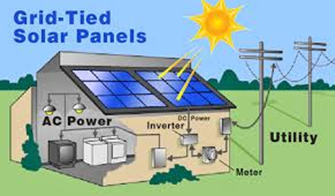Science → Solar Cells → Basics of Solar Electricity Technology
PV TECHNOLOGY
Solar cells or Photovoltaics (PV) are semiconductor devices that convert sunlight into direct current (DC) electricity. Groups of PV cells configured electrically in modules and arrays those are used to charge batteries, operate motors, and to power electrical loads (appliances). With the appropriate power conversion equipment (inverter), PV systems can produce alternating current (AC) compatible with any conventional appliances, and can be operated as a standalone system or could be interconnected to the national grid.

HISTORY OF SOLAR OR PHOTOVOLTAIC (PV) CELLS
The photoelectric effect was first observed by a French physicist Edmund Bequerel in 1839. He noted a small amount of current produced by certain materials on light expose. Albert Einstein in 1905 described the photoelectric effect and the nature of light on which photovoltaic (PV) technology are based, and later he won a Nobel prize in physics. The first conventional photovoltaic cells were produced in the late 1950s, and Bell Laboratories built the first photovoltaic module in 1954. It was built as a solar battery and was too expensive to gain interest.
In the 1960s, the space industry began to make the first serious use of PV technology to provide power aboard spacecraft. The space programs help to establish the advanced technology, its reliability, and the cost began to decline. During the energy crisis in the 1970s, improvements in manufacturing, performance and quality of PV modules helped to reduce costs and opened up some opportunities for powering remote global applications, including battery charging for navigation systems, telecommunications equipment, and other low-power needs.
In the 1980s, PV became an attractive power source for consumer electronic devices, including calculators, watches, radios, lamps and small battery-charging applications. As a result of energy crises in the 1970s, significant efforts were made to develop PV systems for commercial and residential uses, both for standalone, remote power along with utility connected applications. During the same period, applications for PV systems to power rural health clinics, refrigeration, water pumping, telecommunications, and off-grid households increased intensely. It remained a significant portion of the present world market for PV products. Today, the industry’s production of PV modules is growing at approximately 25% annually, and today world is rapidly accelerating in the implementation of PV systems on buildings and to the national grid.